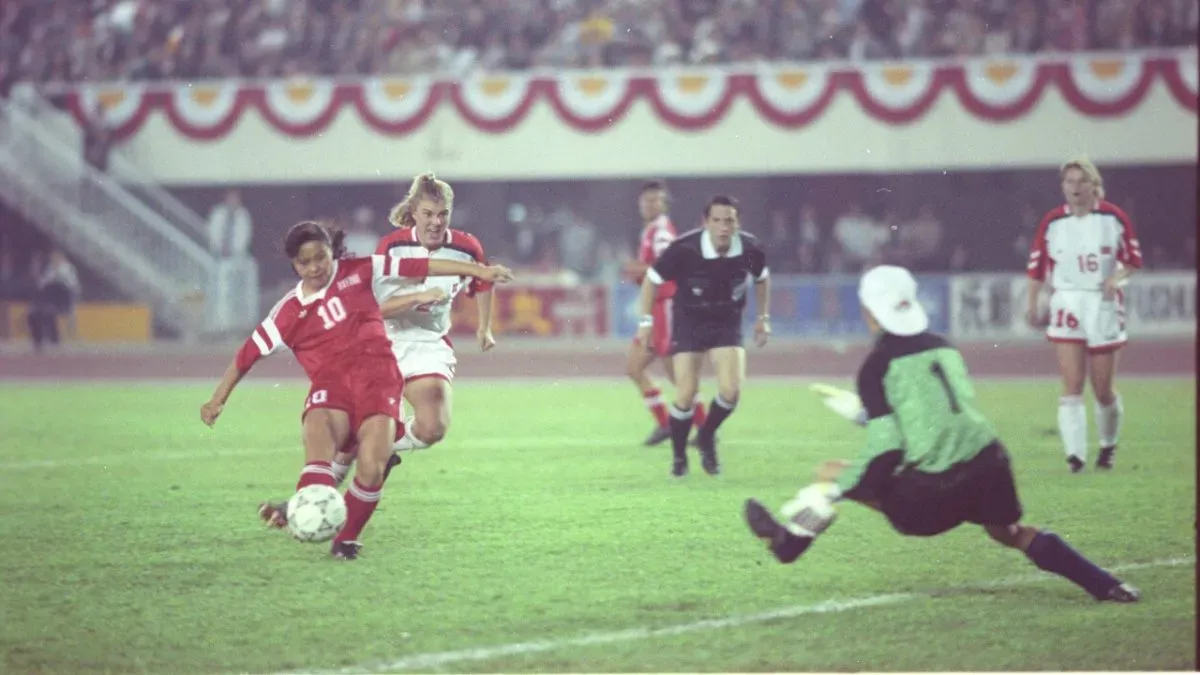As far as sports storylines go, the meteoric rise of women’s soccer ranks among the most fascinating and motivating. A once-overlooked and underappreciated phenomenon has grown into a worldwide sensation, winning over audiences everywhere.
The ascent from obscurity to prominence has been characterized by dogged persistence, fortitude, and the unrelenting quest for acknowledgment and parity. The sport of women’s soccer has seen a meteoric rise in popularity and participation throughout the last three decades.
This has not changed the fact that female soccer players continue to face discrimination. Reduced compensation, less resources, and fewer awards are also bestowed upon them.
Idea behind women’s soccer and early struggles
Preliminary evidence of female soccer players dates back to a match recorded on Shrove Tuesday, 23 February 1773. An event pitting married gentlemen against bachelors took place in the Yorkshire hamlet of Walton.
After an hour of fighting, during which many people suffered fractured shins, they knew they were in over their heads. As soon as she noticed her husband struggling, a courageous lady stepped out into the field to lend him a hand. Despite her opponent’s “superior strength,” she persisted in “pursuing the ball with a determination that brought her victory.”
Then, Edinburgh hosted the first British women’s international soccer match in 1881. The score was 3-0 in favor of the Scots against the English. However, the sport of women’s soccer did not exist in 1894. That was something that Nettie Honeyball set out to alter.
The British Ladies Football Club
She went under a pseudonym and her true identity remains a mystery. However, there may not have been a more fitting person to bring the concept of women’s soccer to England than this anonymous figure. Honeyball helped form the British Ladies Football Club, the first known professional women’s soccer team, alongside about thirty other young ladies.
She created the squad in 1895 to illustrate women weren’t only “ornamental and useless,” she told The Daily Sketch. Thousands of people showed out to see the British Ladies Football Club play during their little stint in the limelight. Their boldness in attempting a “man’s game” garnered them much criticism, nevertheless.
“When the novelty has worn off, I do not think women’s soccer will attract the crowds,” said one journalist after the game.
Although Honeyball and her colleagues were heavily criticized, not everyone thought women couldn’t play the game. One news outlet published:
“True, young men would run harder and kick more strongly, but, beyond this, I cannot believe that they would show any greater knowledge of the game or skill in its execution. I don’t think the lady footballer is to be snuffed out by several leading articles written by old men out of sympathy both with soccer as a game and the aspirations of the young new women. If the lady footballer dies, she will die hard.”
There was an outpouring of criticism and, at times, physical aggression for every little compliment the British Ladies received. The playing field became too dangerous. That dashed the dreams of Nettie Honeyball for women’s soccer.
Outright prohibition on women’s soccer
Nettie Honeyball’s achievements were stifled by bias in the media and the desire of soccer fans to exclude women from the sport. But it wasn’t the end of women’s soccer, either.
The English women’s soccer league was at the height of its popularity during WWI. Women left the factories to start soccer teams while the males were fighting on the front lines. As an example, in 1920, 53,000 people showed out to see a women’s soccer game, which was comparable to the audiences that watch women’s soccer matches today.
The FA outright banned women’s soccer a year after that spectacular gathering of spectators because they thought it was inappropriate and dangerous. It took almost half a century for women to make a substantial comeback on the field.
New international women’s soccer events
In 1970, Italy hosted a Women’s World Cup that FIFA did not officially sanction. It wasn’t until 1971, a year after this competition, that the modern women’s game took off.
More than 100,000 people showed out to see the men’s World Cup in Mexico in 1970. Fans across the world rode that enthusiasm into a women’s World Cup in the same summer. Over 40,000 people attended the final between Mexico and Denmark. By all accounts, it was a spectacle for the women’s game. Moreover, it was a sign of promise for women.
The excitement unfortunately tapered out. Despite that first ‘World Cup’ success, the women’s game would have to wait to have a hold in the sport.

USWNT claim 1999 World Cup win
For female soccer aficionados, the year 1999 conjures up a vivid mental picture at the very mention of the year. Brandi Chastain, who scored the game-winning penalty kick, fell to her knees and celebrated her team’s incredible victory with her jersey held high.
There can be no doubt that the greatest event in the history of the sport was undoubtedly the second World Cup triumph of the USWNT. The sport of women’s soccer was officially recognized that day. Many young women looked up to the squad and wanted to be like them.
The 1999 USWNT had an enormous influence. The players rose to the status of legendary figures in the sport and became household names. Thanks to them, the United States was recognized as the top in the world.
In addition, a professional league started. Women finally had the opportunity to earn the respect they deserved on the pitch. Two American professional leagues died out after the 1999 World Cup, but the National Women’s Soccer League (NWSL) brought some stability to the sport.
Disappointment leads to history
At the turn of the millennium, women’s soccer was booming, with more and more professional leagues springing up across the globe, according to a FIFA study from 2014. But, a lot of people didn’t find the United States’ 2019 Women’s World Cup shocking.
Defeat in this competition was inevitable for the USWNT. All things considered, the 2019 Women’s World Cup was a watershed moment in women’s soccer.
The struggle for gender parity in women’s soccer has been going on for years. Everyone had a say in the events of 2019, though. Although the USWNT’s on-field theatrics and brazen post-victory celebrations garnered them criticism, their message remained unmistakable.
The global popularity of women’s soccer has skyrocketed since 2019. Attendance at the NWSL and FA WSL both hit new highs.
Brazil and England have said that they would pay their women’s and men’s teams the same amount. There has never been a higher viewership of women’s soccer. There has been tremendous progress, but much more work remains.
Women’s soccer in 21st century

As is the case in other sports, professional female soccer players face lesser income and fewer chances than their male counterparts. On a national and international level, women’s soccer receives a fraction of the media attention and typically draws a fraction of the crowds of men’s soccer.
In their pursuit of parity with the U.S. men’s team, the USWNT demanded equal salary. US Soccer eventually agreed to bonus payments after considerable debate and conflict.
After much back-and-forth, the parties involved reached a compromise that saw the players get multimillion-dollar payouts. In addition, the federation pledged to equalize salaries for the men’s and women’s national teams.
However, there is still a gender gap in professional soccer, and some fans can’t tell the difference between men’s and women’s teams, according to studies. No matter how many other aspects keep getting better, female coaches are still not getting the treatment they deserve.
Several European women’s leagues still have a significant lack of representation from this demographic. Still, more and more women are getting into the women’s game.
Barcelona‘s 2021-22 UEFA Women’s Champions League games against Real Madrid and Wolfsburg drew huge crowds. For example, those two games are the largest female football matches based on attendance. 91,553 people were present to see the Blaugrana in the El Clasico women’s derby and another 91,648 against Wolfsburg.
PHOTOS: IMAGO.















